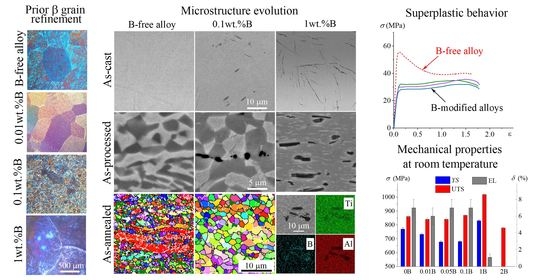Effect of Boron on the Microstructure, Superplastic Behavior, and Mechanical Properties of Ti-4Al-3Mo-1V Alloy
Abstract
1. Introduction
2. Materials and Methods
2.1. Material Processing
2.2. Microstructural and Phase Composition Analyses
2.3. Tensile Tests
3. Results
3.1. Phase Composition Analysis
3.2. Analysis of The Microstructure after Solidification, Thermomechanical Treatment, and Post-Deformation Annealing
3.3. Superplastic Deformation
3.4. Mechanical Properties at Room Temperature
4. Discussion
4.1. Boron Influence on The Prior β-Grain Size after Solidification
4.2. Influence of Trace Addition of 0.01–0.1% B on The Microstructure and Superplasticity
4.3. Influence of 1–2 wt.% B on The Superplastic and Mechanical Properties
5. Conclusions
Author Contributions
Funding
Institutional Review Board Statement
Informed Consent Statement
Data Availability Statement
Conflicts of Interest
References
- Moiseyev, V.N. Titanium Alloys: Russian Aircraft and Aerospace Applications; CRC Press: Boca Raton, FL, USA, 2005; ISBN 9780849332739. [Google Scholar]
- Ridley, N. Metals for Superplastic Forming. In Superplastic Forming of Advanced Metallic Materials; Woodhead Publishing: Sawston, UK, 2011; pp. 3–33. [Google Scholar] [CrossRef]
- Novikov, I.I.; Portnoj, V.K. Superplastizität von Legierungen; VEB Deutscher Verlag fur Grundstoffindustrie, Leipzig; Springer: Vienna, Austria, 1985. [Google Scholar]
- Meier, M.L.; Lesuer, D.R.; Mukherjee, A.K. A Grain Size and β Volume Fraction Aspects of the Superplasticity of Ti-6A1-4V. Mater. Sci. Eng. A 1991, 136, 71–78. [Google Scholar] [CrossRef]
- Sieniawski, J.; Motyka, M. Superplasticity in Titanium Alloys. J. Achiev. Mater. Manuf. Eng. 2007, 24, 123–130. [Google Scholar]
- Sinha, V.; Srinivasan, R.; Tamirisakandala, S.; Miracle, D.B. Superplastic Behavior of Ti-6Al-4V-0.1B Alloy. Mater. Sci. Eng. A 2012, 539, 7–12. [Google Scholar] [CrossRef]
- Roy, S.; Suwas, S. Deformation Mechanisms during Superplastic Testing of Ti-6Al-4V-0.1B Alloy. Mater. Sci. Eng. A 2013, 574, 205–217. [Google Scholar] [CrossRef]
- Imayev, V.M.; Gaisin, R.A.; Imayev, R.M. Effect of Boron Addition on Formation of a Fine-Grained Microstructure in Commercially Pure Titanium Processed by Hot Compression. Mater. Sci. Eng. A 2015, 639, 691–698. [Google Scholar] [CrossRef]
- Roy, S.; Suwas, S.; Tamirisakandala, S.; Miracle, D.B.; Srinivasan, R. Development of Solidification Microstructure in Boron-Modified Alloy Ti-6Al-4V-0.1B. Acta Mater. 2011, 59, 5494–5510. [Google Scholar] [CrossRef]
- Singh, G.; Ramamurty, U. Boron Modified Titanium Alloys. Prog. Mater. Sci. 2020, 111, 100653. [Google Scholar] [CrossRef]
- Palty, A.E.; Margolin, H.; Nielsen, J.P. Titanium Nitrogen and Titanium Boron Systems. Trans. Am. Soc. Met. 1954, 46, 312–328. [Google Scholar]
- Yang, Y.F.; Yan, M.; Luo, S.D.; Schaffer, G.B.; Qian, M. Modification of the α-Ti Laths to near Equiaxed α-Ti Grains in as-Sintered Titanium and Titanium Alloys by a Small Addition of Boron. J. Alloys Compd. 2013, 579, 553–557. [Google Scholar] [CrossRef]
- Nandwana, P.; Nag, S.; Hill, D.; Tiley, J.; Fraser, H.L.; Banerjee, R. On the Correlation between the Morphology of α and Its Crystallographic Orientation Relationship with TiB and β in Boron-Containing Ti-5Al-5Mo-5V-3Cr-0.5Fe Alloy. Scr. Mater. 2012, 66, 598–601. [Google Scholar] [CrossRef]
- Sasaki, T.T.; Fu, B.; Torres, K.; Thompson, G.B.; Srinivasan, R.; Cherukuri, B.; Tiley, J. Nucleation and Growth of α-Ti on TiB Precipitates in Ti-15Mo-2.6Nb-3Al-0.2Si-0.12B. Philos. Mag. 2011, 91, 850–864. [Google Scholar] [CrossRef]
- Sen, I.; Tamirisakandala, S.; Miracle, D.; Ramamurty, U. Microstructural Effects on the Mechanical Behavior of B-Modified Ti–6Al–4V Alloys. Acta Mater. 2007, 55, 4983–4993. [Google Scholar] [CrossRef]
- Chong, Y.; Gholizadeh, R.; Yamamoto, K.; Tsuji, N. New Insights into the Colony Refinement Mechanism by Solute Boron Atoms in Ti-6Al-4V Alloy. Scr. Mater. 2023, 230, 115397. [Google Scholar] [CrossRef]
- Roy, S.; Suwas, S. The Influence of Temperature and Strain Rate on the Deformation Response and Microstructural Evolution during Hot Compression of a Titanium Alloy Ti–6Al–4V–0.1B. J. Alloys Compd. 2013, 548, 110–125. [Google Scholar] [CrossRef]
- Gaisin, R.A.; Imayev, V.M.; Imayev, R.M.; Gaisina, E.R. Effect of Boron Addition on Recrystallization Behavior of Commercially Pure Titanium Subjected to Hot Compression. Lett. Mater. 2015, 5, 124–128. [Google Scholar] [CrossRef]
- Srinivasan, R.; Miracle, D.; Tamirisakandala, S. Direct Rolling of As-Cast Ti-6Al-4V Modified with Trace Additions of Boron. Mater. Sci. Eng. A 2008, 487, 541–551. [Google Scholar] [CrossRef]
- Roy, S.; Sarkar, A.; Suwas, S. On Characterization of Deformation Microstructure in Boron Modified Ti-6Al-4V Alloy. Mater. Sci. Eng. A 2010, 528, 449–458. [Google Scholar] [CrossRef]
- Gaisin, R.A.; Imayev, V.M.; Imayev, R.M.; Gaisina, E.R. Microstructure and Hot Deformation Behavior of Two-Phase Boron-Modified Titanium Alloy VT8. Phys. Met. Metallogr. 2013, 114, 339–347. [Google Scholar] [CrossRef]
- Stefanescu, D.M.; Ruxanda, R. Solidification Structures of Titanium Alloys. In Metallography and Microstructures; ASM International: Detroit, MI, USA, 2004; pp. 116–126. [Google Scholar]
- Cheng, T. The Mechanism of Grain Refinement in TiAl Alloys by Boron Addition—An Alternative Hypothesis. Intermetallics 2000, 8, 29–37. [Google Scholar] [CrossRef]
- Tamirisakandala, S.; Bhat, R.B.; Tiley, J.S.; Miracle, D.B. Grain Refinement of Cast Titanium Alloys via Trace Boron Addition. Scr. Mater. 2005, 53, 1421–1426. [Google Scholar] [CrossRef]
- Cherukuri, B.; Srinivasan, R.; Tamirisakandala, S.; Miracle, D. The Influence of Trace Boron Addition on Grain Growth Kinetics of the Beta Phase in the Beta Titanium Alloy Ti–15Mo–2.6Nb–3Al–0.2Si. Scr. Mater. 2009, 60, 496–499. [Google Scholar] [CrossRef]
- Bilous, O.O.; Artyukh, L.V.; Bondar, A.A.; Velikanova, T.Y.; Burka, M.P.; Brodnikovskyi, M.P.; Fomichov, O.S.; Tsyganenko, N.I.; Firstov, S.O. Effect of Boron on the Structure and Mechanical Properties of Ti–6Al and Ti–6Al–4V. Mater. Sci. Eng. A 2005, 402, 76–83. [Google Scholar] [CrossRef]
- Luan, J.H.; Jiao, Z.B.; Chen, G.; Liu, C.T. Improved Ductility and Oxidation Resistance of Cast Ti–6Al–4V Alloys by Microalloying. J. Alloys Compd. 2014, 602, 235–240. [Google Scholar] [CrossRef]
- Roy, S.; Suwas, S. Enhanced Superplasticity for (A+β)-Hot Rolled Ti-6Al-4V-0.1B Alloy by Means of Dynamic Globularization. Mater. Des. 2014, 58, 52–64. [Google Scholar] [CrossRef]
- Kotov, A.D.; Postnikova, M.N.; Mosleh, A.O.; Mikhaylovskaya, A.V. Influence of Fe on the Microstructure, Superplasticity and Room-Temperature Mechanical Properties of Ti–4Al–3Mo–1V-0.1B Alloy. Mater. Sci. Eng. A 2022, 845, 143245. [Google Scholar] [CrossRef]
- Tamirisakandaia, S.; Miracle, D.B.; Srinivasan, R.; Gunasekera, J.S. Titanium Alloyed with Boron. Adv. Mater. Process. 2006, 164, 41–43. [Google Scholar]
- Hill, D.; Banerjee, R.; Huber, D.; Tiley, J.; Fraser, H.L. Formation of Equiaxed Alpha in TiB Reinforced Ti Alloy Composites. Scr. Mater. 2005, 52, 387–392. [Google Scholar] [CrossRef]
- Ivasishin, O.M.; Teliovych, R.V.; Ivanchenko, V.G.; Tamirisakandala, S.; Miracle, D.B. Processing, Microstructure, Texture, and Tensile Properties of the Ti-6Al-4V-1.55B Eutectic Alloy. Metall. Mater. Trans. A 2008, 39, 402–416. [Google Scholar] [CrossRef]
- Zadorozhnyy, V.Y.; Shchetinin, I.V.; Chirikov, N.V.; Louzguine-Luzgin, D.V. Tensile Properties of a Dual-Axial Forged Ti–Fe–Cu Alloy Containing Boron. Mater. Sci. Eng. A 2014, 614, 238–242. [Google Scholar] [CrossRef]
- Chandravanshi, V.K.; Sarkar, R.; Kamat, S.V.; Nandy, T.K. Effect of Boron on Microstructure and Mechanical Properties of Thermomechanically Processed near Alpha Titanium Alloy Ti-1100. J. Alloys Compd. 2011, 509, 5506–5514. [Google Scholar] [CrossRef]
- Kotov, A.D.; Mikhailovskaya, A.V.; Mosleh, A.O.; Pourcelot, T.P.; Prosviryakov, A.S.; Portnoi, V.K. Superplasticity of an Ultrafine-Grained Ti–4% Al–1% V–3% Mo Alloy. Phys. Met. Metallogr. 2019, 120, 60–68. [Google Scholar] [CrossRef]
- Mosleh, A.O.; Mikhaylovskaya, A.V.; Kotov, A.D.; Sitkina, M.; Mestre-Rinn, P.; Kwame, J.S. Superplastic Deformation Behavior of Ultra-Fine-Grained Ti-1V-4Al-3Mo Alloy: Constitutive Modeling and Processing Map. Mater. Res. Express 2019, 6, 96584. [Google Scholar] [CrossRef]
- Mosleh, A.O.; Kotov, A.D.; Vidal, V.; Mochugovskiy, A.G.; Velay, V.; Mikhaylovskaya, A.V. Initial Microstructure Influence on Ti–Al–Mo–V Alloy’s Superplastic Deformation Behavior and Deformation Mechanisms. Mater. Sci. Eng. A 2021, 802, 140626. [Google Scholar] [CrossRef]
- Mikhaylovskaya, A.V.; Mosleh, A.O.; Mestre-Rinn, P.; Kotov, A.D.; Sitkina, M.N.; Bazlov, A.I.; Louzguine-Luzgin, D.V. High-Strength Titanium-Based Alloy for Low-Temperature Superplastic Forming. Metall. Mater. Trans. A Phys. Metall. Mater. Sci. 2021, 52, 293–302. [Google Scholar] [CrossRef]
- Suzuki, Y.; Xu, Y.; Morito, S.; Otsuka, K.; Mitose, K. Effects of Boron Addition on Microstructure and Mechanical Properties of Ti–Td–Ni High-Temperature Shape Memory Alloys. Mater. Lett. 1998, 36, 85–94. [Google Scholar] [CrossRef]
- Yen, F.-C.; Hwang, K.-C. Microstructures, Mechanical Properties, and Shape Memory Characteristics of Powder Metallurgy Ti51Ni49 Modified with Boron. Metall. Mater. Trans. A 2012, 43, 687–696. [Google Scholar] [CrossRef]
- Liu, C.T.; Schneibel, J.H.; Maziasz, P.J.; Wright, J.L.; Easton, D.S. Tensile Properties and Fracture Toughness of TiAl Alloys with Controlled Microstructures. Intermetallics 1996, 4, 429–440. [Google Scholar] [CrossRef]
- Christodoulou, J.A.; Flower, H.M. The Role of Borides in Near-γ Titanium Aluminides. Adv. Eng. Mater. 2000, 2, 631–638. [Google Scholar] [CrossRef]
- Hu, D. A Quarter Century Journey of Boron as a Grain Refiner in TiAl Alloys. TMS Annu. Meet. 2014, 2014, 21–30. [Google Scholar] [CrossRef]
- Bermingham, M.J.; McDonald, S.D.; Nogita, K.; John, D.H.S.; Dargusch, M.S. Effects of Boron on Microstructure in Cast Titanium Alloys. Scr. Mater. 2008, 59, 538–541. [Google Scholar] [CrossRef]
- Tamirisakandala, S.; Bhat, R.B.; Miracle, D.B.; Boddapati, S.; Bordia, R.; Vanover, R.; Vasudevan, V.K. Effect of Boron on the Beta Transus of Ti-6Al-4V Alloy. Scr. Mater. 2005, 53, 217–222. [Google Scholar] [CrossRef]
- Kishchik, A.A.; Mikhaylovskaya, A.V.; Levchenko, V.S.; Portnoy, V.K. Formation of Microstructure and the Superplasticity of Al–Mg-Based Alloys. Phys. Met. Metallogr. 2017, 118, 96–103. [Google Scholar] [CrossRef]
- Tarshis, L.A.; Walker, J.L.; Rutter, J.W. Experiments on the Solidification Structure of Alloy Castings. Metall. Trans. 1971, 2, 2589–2597. [Google Scholar] [CrossRef]
- Gan, G.; Yang, B.; Zhang, B.; Jiang, X.; Shi, Y.; Wu, Y. Refining Mechanism of 7075 Al Alloy by In-Situ TiB2 Particles. Materials 2017, 10, 132. [Google Scholar] [CrossRef]
- Sun, M.; Yang, D.; Zhang, Y.; Mao, L.; Li, X.; Pang, S. Recent Advances in the Grain Refinement Effects of Zr on Mg Alloys: A Review. Metals 2022, 12, 1388. [Google Scholar] [CrossRef]
- Okamoto, H.; Massalski, T.B. Section I: Basic and Applied Research Binary Alloy Phase Diagrams. J. Phase Equilibria 1994, 15, 500–521. [Google Scholar] [CrossRef]
- Anil Kumar, V.; Murty, S.V.S.N.; Gupta, R.K.; Rao, A.G.; Prasad, M.J.N.V. Effect of Boron on Microstructure Evolution and Hot Tensile Deformation Behavior of Ti-5Al-5V-5Mo-1Cr-1Fe Alloy. J. Alloys Compd. 2020, 831, 154672. [Google Scholar] [CrossRef]
- Nieh, T.G.; Wadsworth, J.; Sherby, O.D. Superplasticity in Metals and Ceramics; Cambridge University Press: Cambridge, UK, 1997; ISBN 9780521561051. [Google Scholar]
- Yutao Zhai, P.S.; Bolzoni, L.; Qu, Y. Fabrication and Characterization of In Situ Ti-6Al-4V/TiB. Metals 2022, 12, 2038. [Google Scholar] [CrossRef]
- Zhu, J.; Kamiya, A.; Yamada, T.; Shi, W.; Naganuma, K. Influence of Boron Addition on Microstructure and Mechanical Properties of Dental Cast Titanium Alloys. Mater. Sci. Eng. A 2003, 339, 53–62. [Google Scholar] [CrossRef]
- Zherebtsov, S.; Ozerov, M.; Klimova, M.; Stepanov, N.; Vershinina, T.; Ivanisenko, Y.; Salishchev, G. Effect of High-Pressure Torsion on Structure and Properties of Ti-15Mo/TiB Metal-Matrix Composite. Materials 2018, 11, 2426. [Google Scholar] [CrossRef]
- Markovsky, P.E.; Janiszewski, J.; Stasyuk, O.O.; Bondarchuk, V.I.; Savvakin, D.G.; Cieplak, K.; Goran, D.; Soni, P.; Prikhodko, S.V. Mechanical Behavior of Titanium Based Metal Matrix Composites Reinforced with TiC or TiB Particles under Quasi-Static and High Strain-Rate Compression. Materials 2021, 14, 6837. [Google Scholar] [CrossRef] [PubMed]
- Zhou, L.; Liu, G.; Ma, X.L.; Lu, K. Strain-Induced Refinement in a Steel with Spheroidal Cementite Subjected to Surface Mechanical Attrition Treatment. Acta Mater. 2008, 56, 78–87. [Google Scholar] [CrossRef]
- Wu, T.; Wang, M.; Gao, Y.; Li, X.; Zhao, Y.; Zou, Q. Effects of Plastic Warm Deformation on Cementite Spheroidization of a Eutectoid Steel. J. Iron Steel Res. Int. 2012, 19, 60–66. [Google Scholar] [CrossRef]
- Portnoy, V.K.; Rylov, D.S.; Levchenko, V.S.; Mikhaylovskaya, A.V. The Influence of Chromium on the Structure and Superplasticity of Al–Mg–Mn Alloys. J. Alloys Compd. 2013, 581, 313–317. [Google Scholar] [CrossRef]
- Kishchik, A.A.; Kotov, A.D.; Mikhaylovskaya, A.V. The Microstructure and High-Strain-Rate Superplasticity of the Al–Mg–Ni–Fe–Mn–Cr–Zr Alloy. Phys. Met. Metallogr. 2019, 120, 1006–1013. [Google Scholar] [CrossRef]

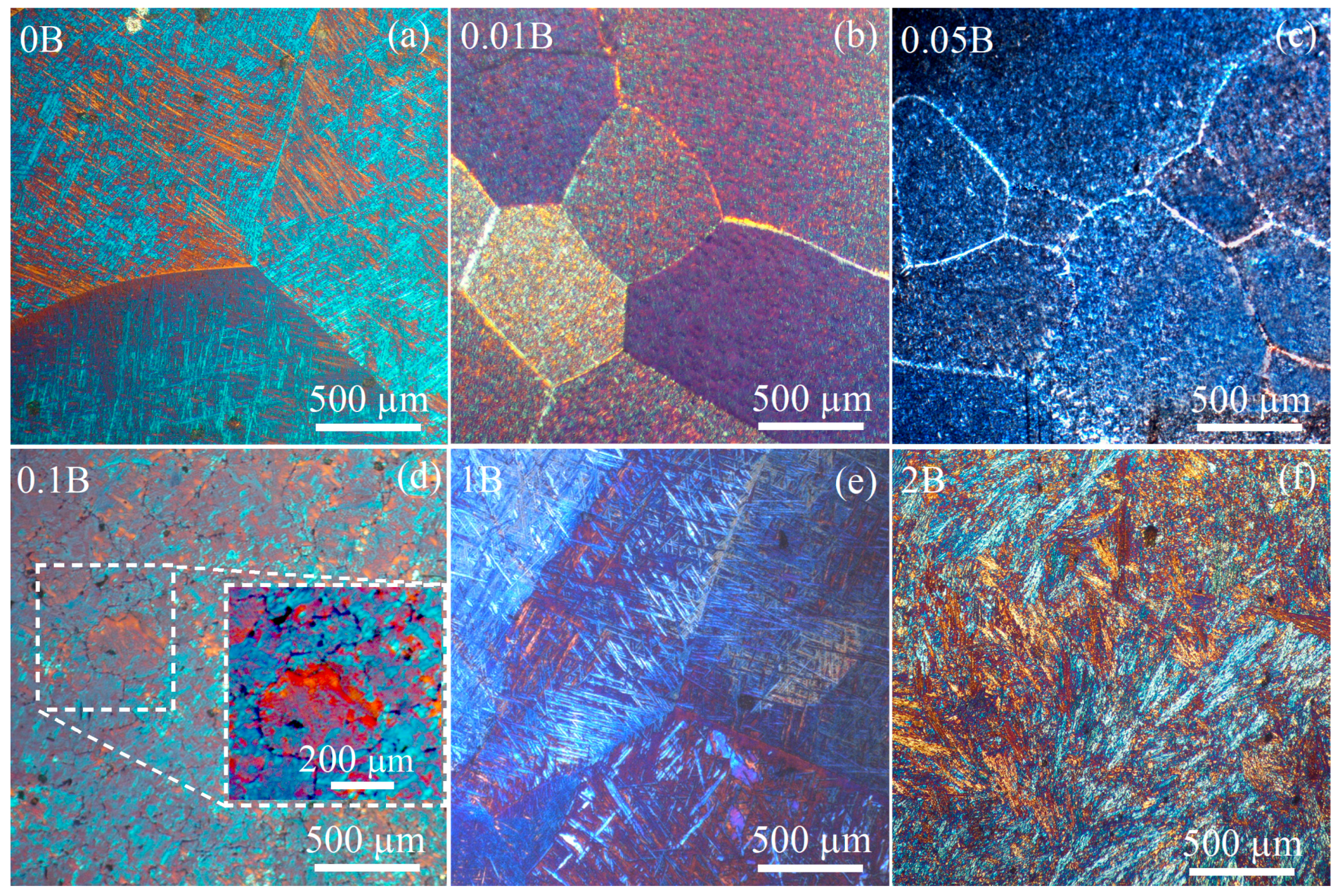
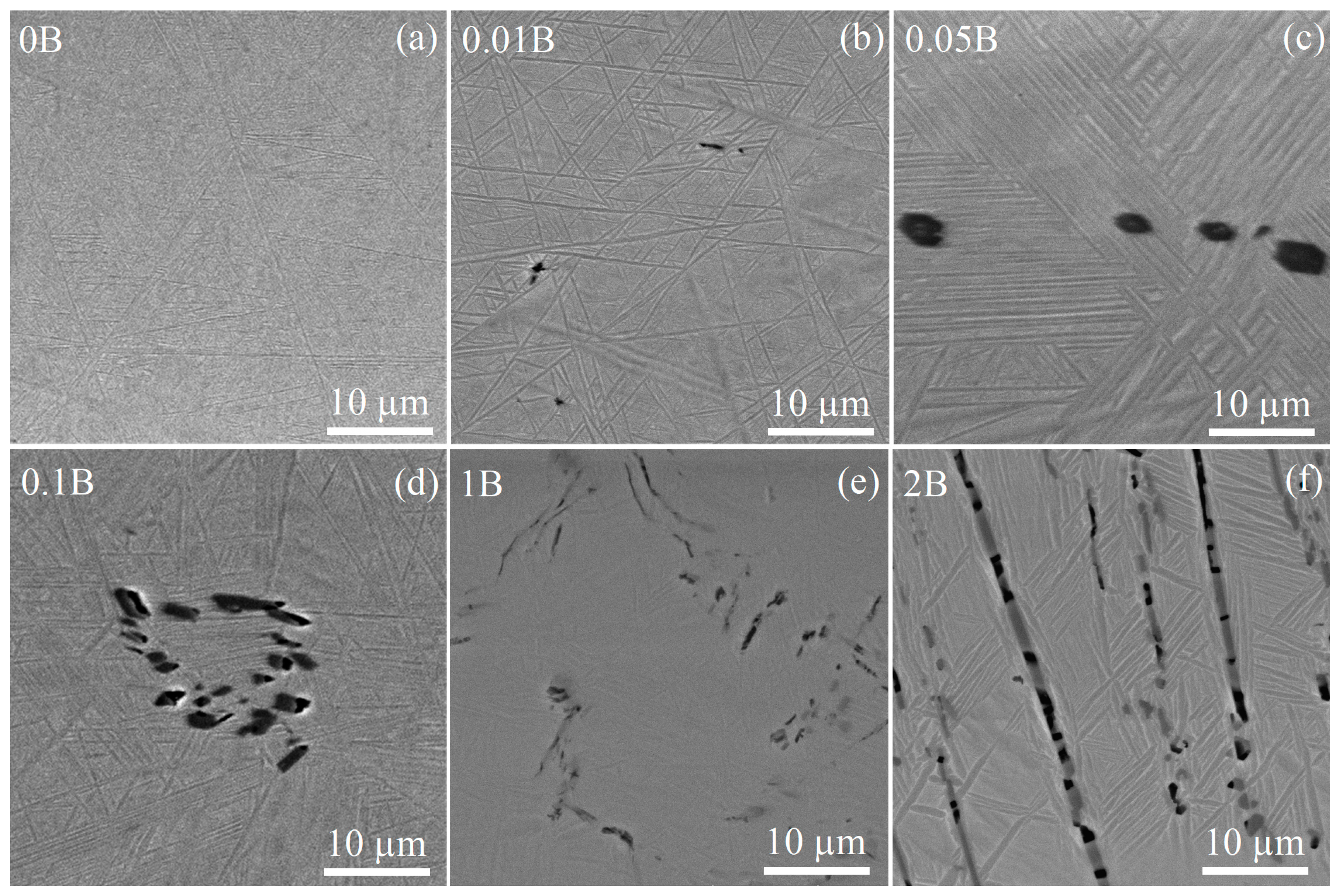
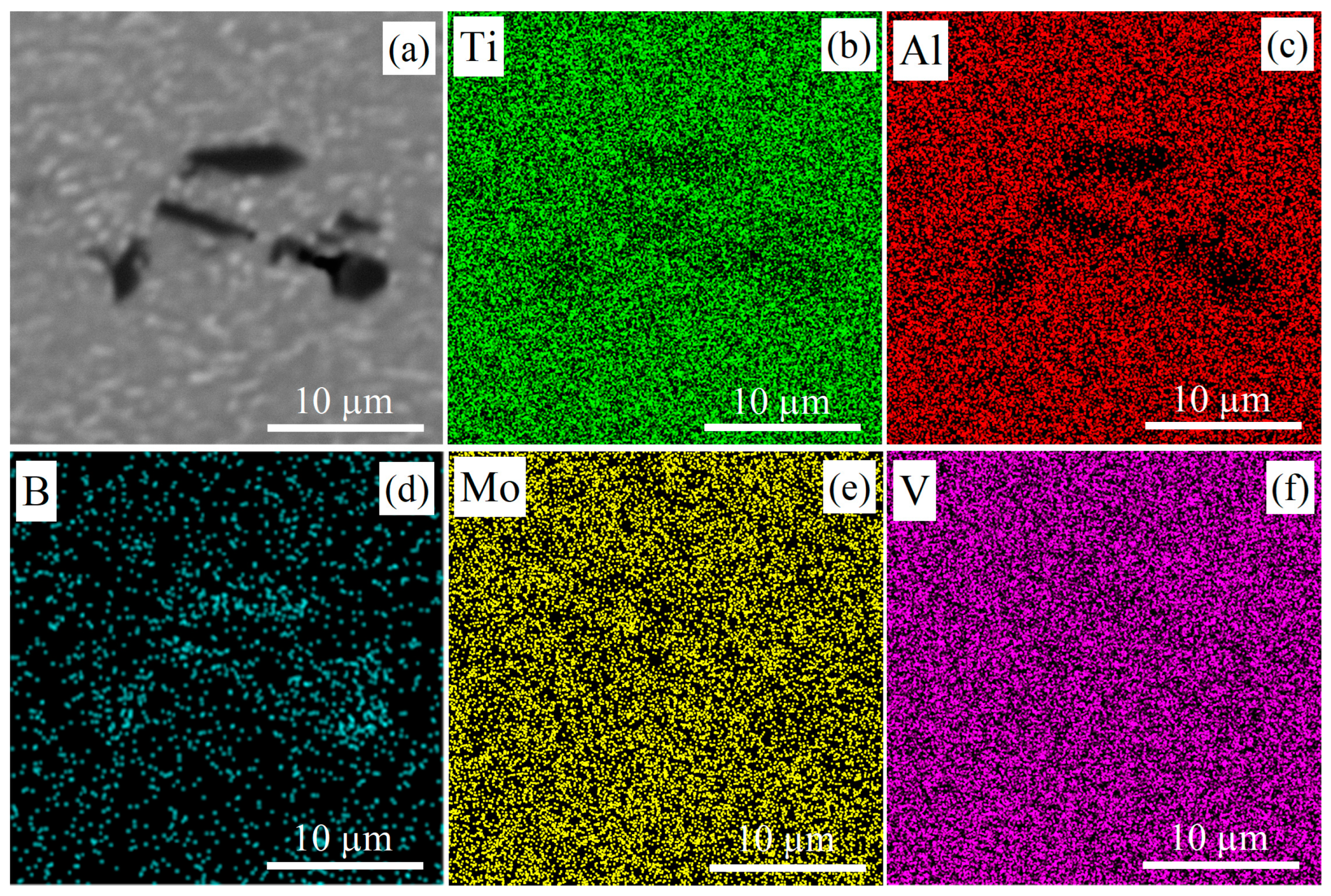
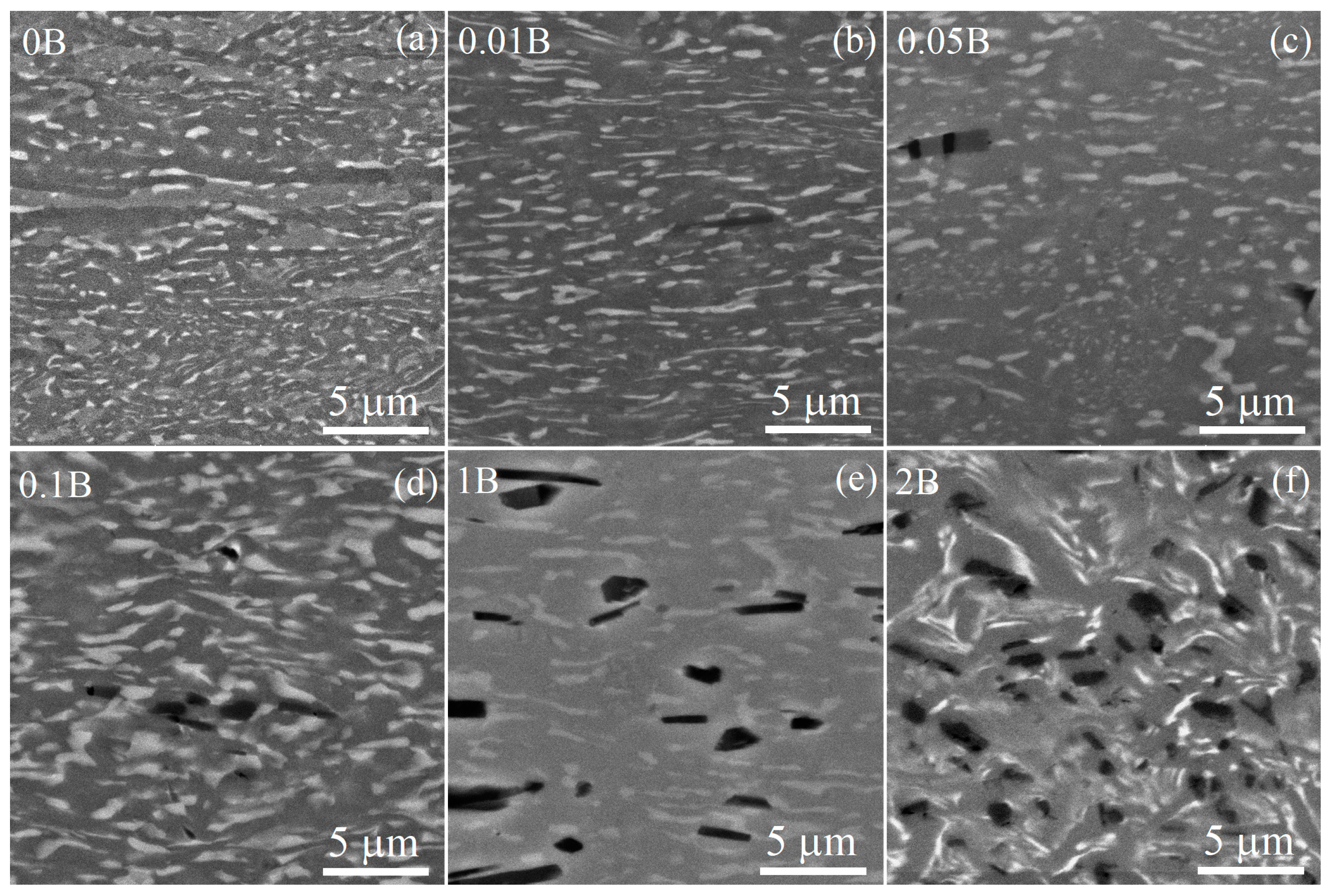
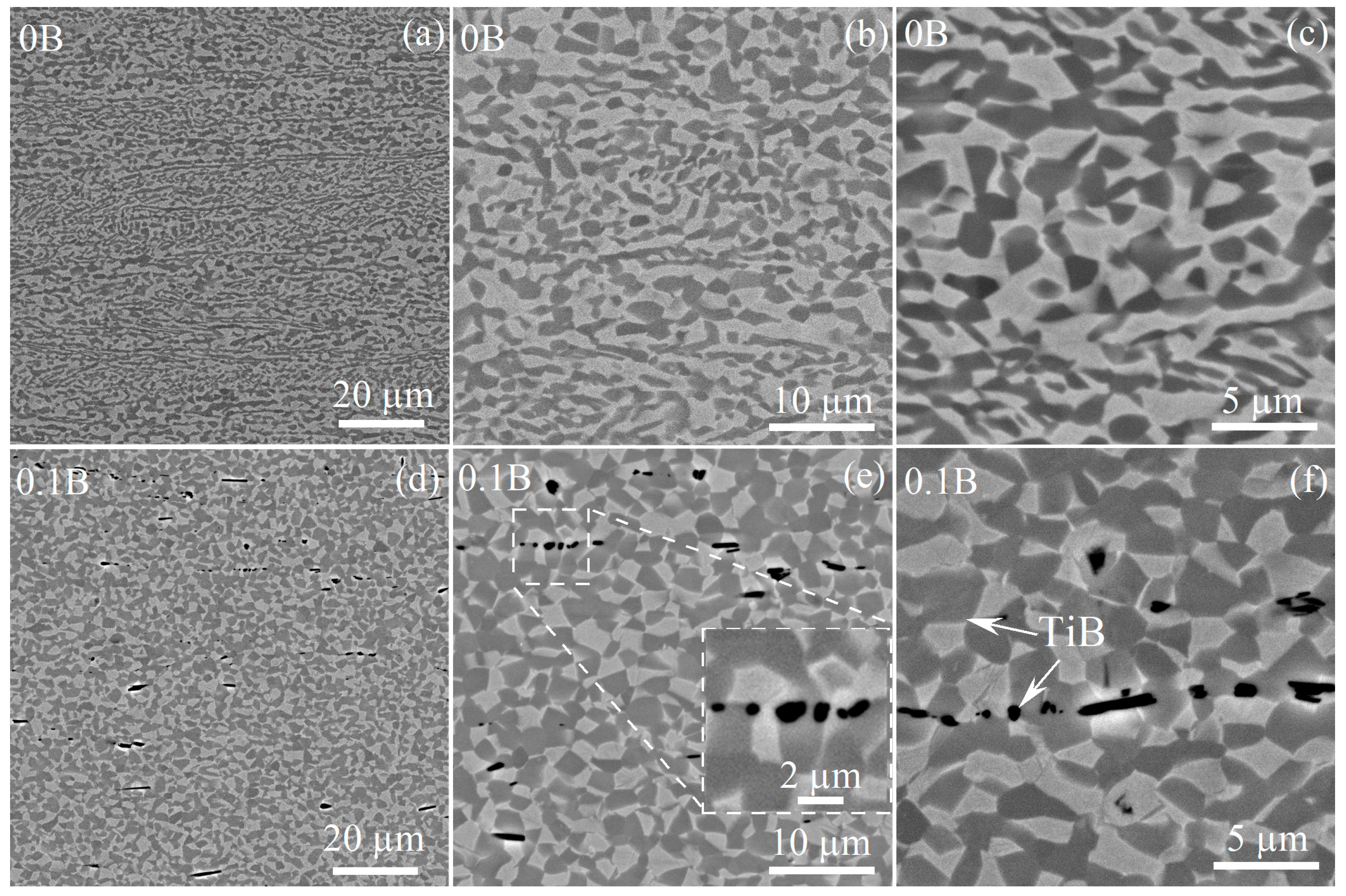
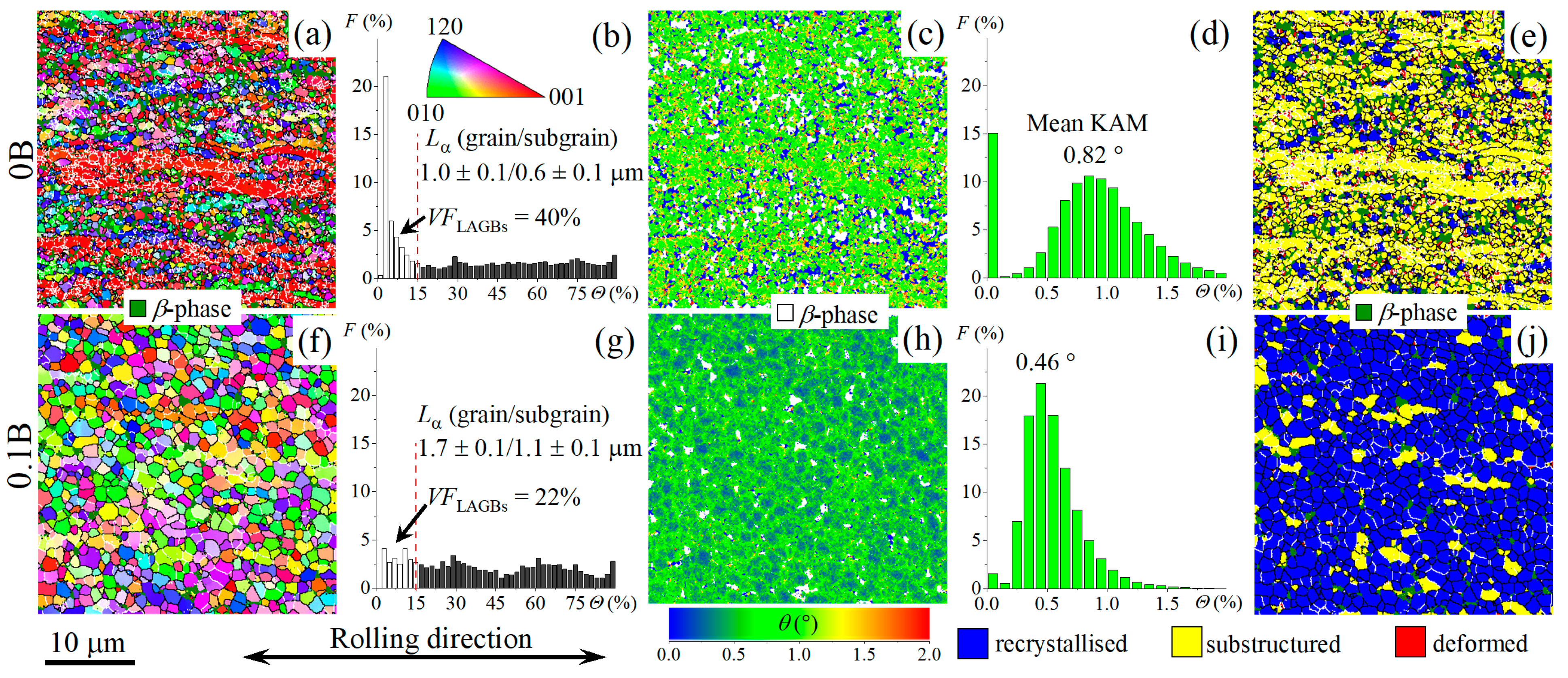
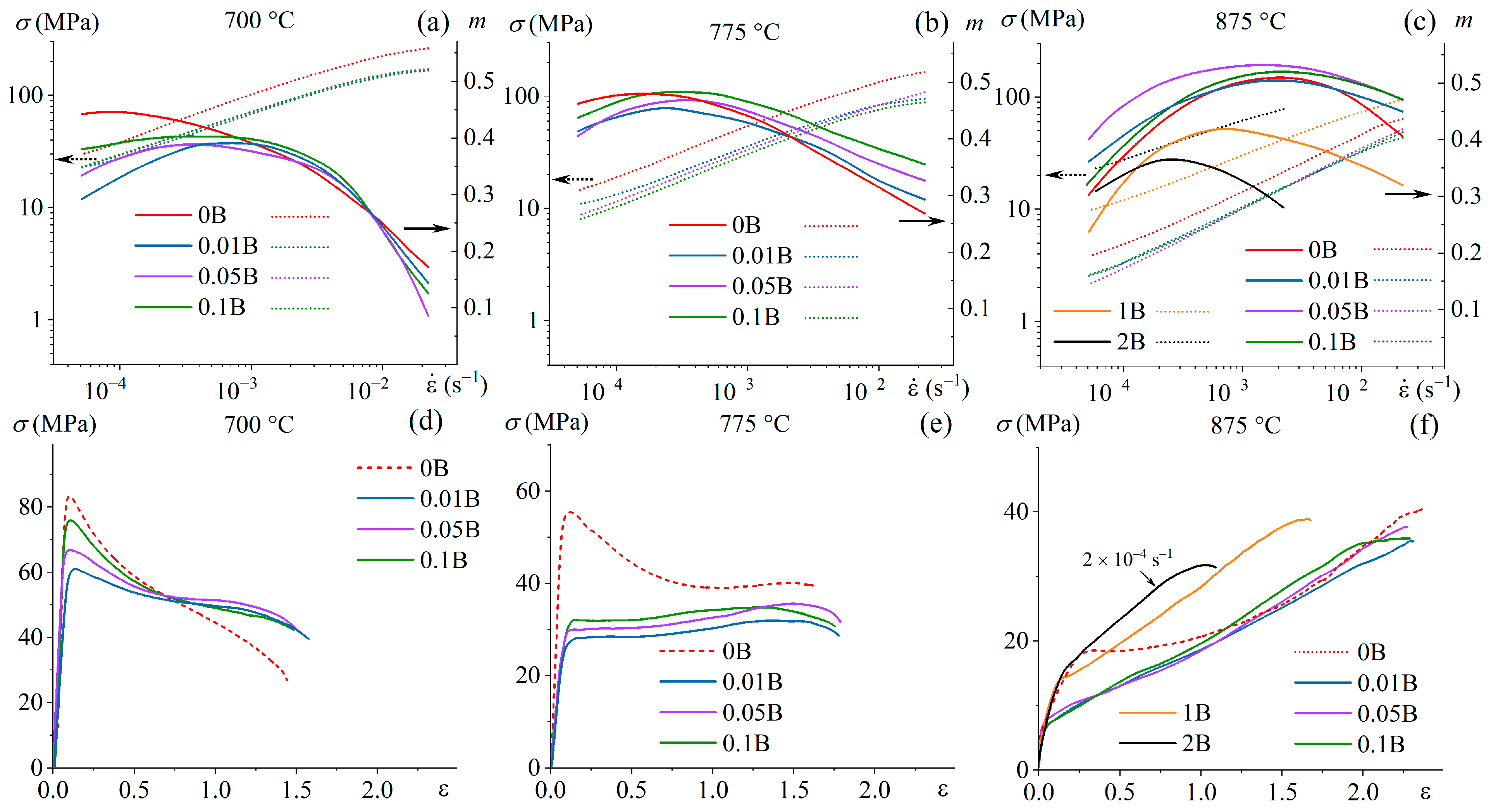
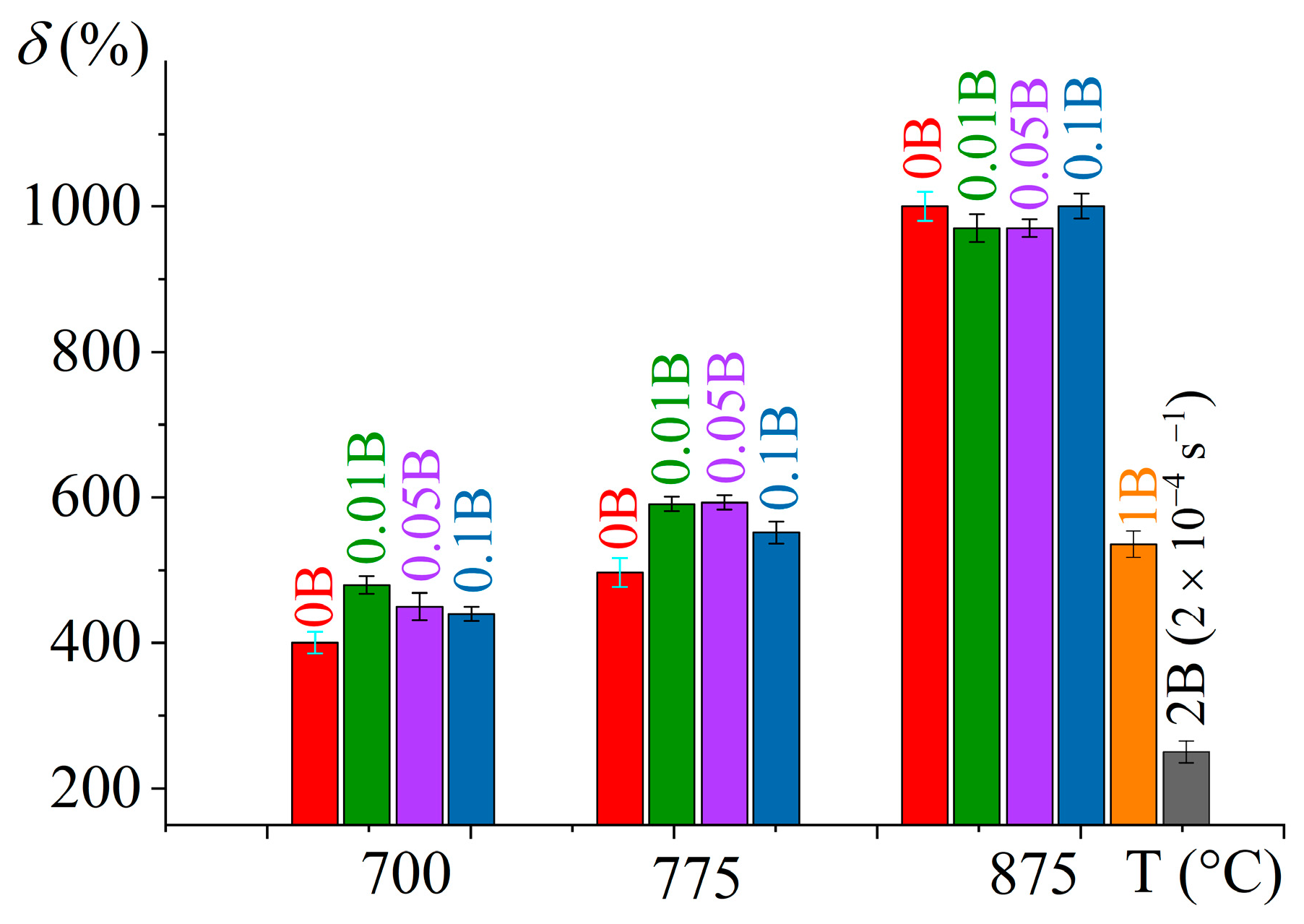
| Alloy | Al | Mo | V | B | Ti |
|---|---|---|---|---|---|
| 0B | 4.2 | 3.0 | 1.1 | – | Bal. |
| 0.01B | 4.1 | 3.2 | 1.0 | 0.01 | Bal. |
| 0.05B | 4.1 | 2.9 | 0.9 | 0.05 | Bal. |
| 0.1B | 3.9 | 3.1 | 1.1 | 0.1 | Bal. |
| 1B | 4.2 | 3.0 | 1.0 | 1 | Bal. |
| 2B | 4.3 | 3.1 | 1.1 | 2 | Bal. |
| Alloy | TiB Size (µm) | TiB Volume Fraction f (%) | Grain Size (µm) |
|---|---|---|---|
| 0B | – | – | 700 ± 70 |
| 0.01B | 0.7 ± 0.2 | 0.1 | 490 ± 40 |
| 0.05B | 1.4 ± 0.3 | 0.2 | 410 ± 30 |
| 0.1B | 2.5 ± 0.4 | 1.1 | 210 ± 20 |
| 1B | 2.5 ± 0.5 | 5.0 | 670 ± 50 |
| 2B | 2.9 ± 0.5 | 10.8 | 750 ± 80 |
| Alloy | TiB Size (µm) | L⊥/L∥ | Grain Size (µm) | Volume Fraction (%) | ||||
|---|---|---|---|---|---|---|---|---|
| L∥ | L⊥ | α | β | α | β | TiB | ||
| 0B * | – | – | – | 1.0 ± 0.2 | 0.5 ± 0.1 | 80 | 20 | – |
| 0.01B * | 2.1 ± 0.3 | 0.6 ± 0.1 | 0.3 | 1.0 ± 0.1 | 0.7 ± 0.1 | 82 | 18 | 0.2 |
| 0.05B * | 2.2 ± 0.4 | 0.7 ± 0.1 | 0.3 | 1.0 ± 0.1 | 0.7 ± 0.1 | 80 | 20 | 0.3 |
| 0.1B * | 2.8 ± 0.2 | 0.7 ± 0.3 | 0.2 | 0.9 ± 0.1 | 0.6 ± 0.1 | 78 | 18 | 1.1 |
| 1B ** | 3.1 ± 0.9 | 0.7 ± 0.2 | 0.2 | 1.2 ± 0.1 | 0.8 ± 0.1 | 76 | 19 | 5.2 |
| 2B ** | 1.0 ± 0.2 | 1.0 ± 0.1 | 1.0 | 1.0 ± 0.1 | 0.6 ± 0.1 | 70 | 20 | 10.5 |
| Alloy | YS (MPa) | UTS (MPa) | δ (%) |
|---|---|---|---|
| 100 pct strain at 875 °C/1 × 10−3 s−1 and air cooling | |||
| 0B | 770 ± 10 | 860 ± 10 | 7 ± 1 |
| 0.01B | 733 ± 7 | 840 ± 10 | 7 ± 1 |
| 0.05B | 678 ± 8 | 840 ± 10 | 7 ± 1 |
| 0.1B | 680 ± 7 | 870 ± 5 | 7 ± 1 |
| 1B | 830 ± 8 | 1020 ± 6 | 1.1 ± 0.4 |
| 2B | – | 778 ± 5 | – |
| 100 pct strain at 875 °C/1 × 10−3 s−1, water cooling and ageing at 480 °C for 16 h | |||
| 0.01B | 865 ± 7 | 982 ± 8 | 7 ± 1 |
| 0.1B | 780 ± 7 | 960 ± 5 | 5 ± 1 |
Disclaimer/Publisher’s Note: The statements, opinions and data contained in all publications are solely those of the individual author(s) and contributor(s) and not of MDPI and/or the editor(s). MDPI and/or the editor(s) disclaim responsibility for any injury to people or property resulting from any ideas, methods, instructions or products referred to in the content. |
© 2023 by the authors. Licensee MDPI, Basel, Switzerland. This article is an open access article distributed under the terms and conditions of the Creative Commons Attribution (CC BY) license (https://creativecommons.org/licenses/by/4.0/).
Share and Cite
Postnikova, M.N.; Kotov, A.D.; Bazlov, A.I.; Mosleh, A.O.; Medvedeva, S.V.; Mikhaylovskaya, A.V. Effect of Boron on the Microstructure, Superplastic Behavior, and Mechanical Properties of Ti-4Al-3Mo-1V Alloy. Materials 2023, 16, 3714. https://doi.org/10.3390/ma16103714
Postnikova MN, Kotov AD, Bazlov AI, Mosleh AO, Medvedeva SV, Mikhaylovskaya AV. Effect of Boron on the Microstructure, Superplastic Behavior, and Mechanical Properties of Ti-4Al-3Mo-1V Alloy. Materials. 2023; 16(10):3714. https://doi.org/10.3390/ma16103714
Chicago/Turabian StylePostnikova, Maria N., Anton D. Kotov, Andrey I. Bazlov, Ahmed O. Mosleh, Svetlana V. Medvedeva, and Anastasia V. Mikhaylovskaya. 2023. "Effect of Boron on the Microstructure, Superplastic Behavior, and Mechanical Properties of Ti-4Al-3Mo-1V Alloy" Materials 16, no. 10: 3714. https://doi.org/10.3390/ma16103714
APA StylePostnikova, M. N., Kotov, A. D., Bazlov, A. I., Mosleh, A. O., Medvedeva, S. V., & Mikhaylovskaya, A. V. (2023). Effect of Boron on the Microstructure, Superplastic Behavior, and Mechanical Properties of Ti-4Al-3Mo-1V Alloy. Materials, 16(10), 3714. https://doi.org/10.3390/ma16103714








